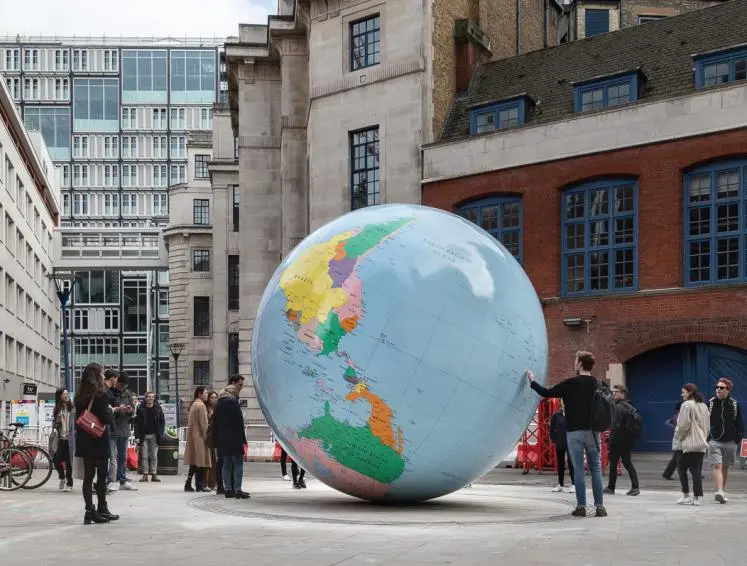"The World Turned Upside Down" - LSE unveils new sculpture by Mark Wallinger

LSE has today unveiled a new sculpture on campus by the Turner Prize-winning artist Mark Wallinger.
Located outside LSE’s Saw Swee Hock Student Centre, The World Turned Upside Down is a large political globe, four metres in diameter, with nation states and borders outlined but with the simple and revolutionary twist of being inverted. Most of the landmasses now lie in the ‘bottom’ hemisphere with the countries and cities re-labelled for this new orientation.
What becomes clear at this scale, and on a globe rather than the flat, rectangular Mercator projection we are used to seeing, is the proper scale of Africa in comparison with the other continents, and the vastness of the oceans.
Mark Wallinger, artist, said: "The UN is the authority as to the names and borders. This is the world, as we know it from a different viewpoint. Familiar, strange, and subject to change."
Recognising LSE’s expertise as a specialist university, with an international community and a global reach, Wallinger created the work to reflect the spirit of progressive enquiry that has characterised the School since its inception.
The World Turned Upside Down is a famous ballad from the English Revolution. It was used as the title for Christopher Hill’s classic account of radical underground movements from that time, and Leon Rosselson’s song in tribute to Gerrard Winstanley and the ideals of the Digger Community:
‘When once the earth becomes a common treasury again, as it must ... then this enmity of all lands will cease, and none shall dare to seek dominion over others, neither shall any dare to kill another, nor desire more of the earth than another.’ Gerrard Winstanley 1649, The True Levellers Standard Advanced.
The project has been curated by Contemporary Art Society Consultancy, which has worked with LSE for thirteen years to deliver art in the public realm for its campus central London.
Welcoming the new sculpture, LSE Director Minouche Shafik said:
"This bold new work by Mark Wallinger reflect's LSE's commitment to tackling the biggest global challenges through our research and teaching. This often means seeing the world from different and unfamiliar points of view."
Fabienne Nicholas, Head of Consultancy at the Contemporary Art Society, said:
"LSE is a university with a truly global reach and Mark’s astute understanding of the social and political context of our times has produced a remarkable work that comments on the state of our world today. We are proud to have been commissioning great art for the LSE for over a decade and The World Turned Upside Down is a significant contribution to this important body of public artwork."